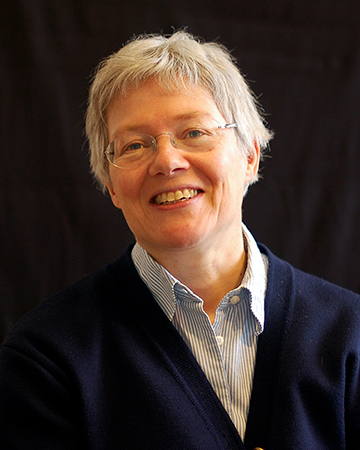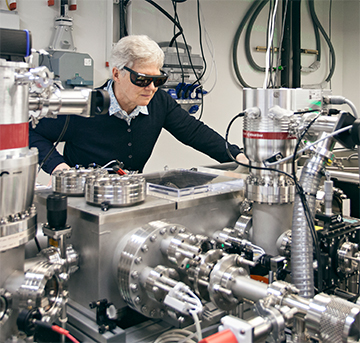
Anne L’Huillier. [Image: Courtesy of A. L’Huillier]
At this year’s Frontiers in Optics + Laser Science (FiO+LS) meeting—which, like the 2020 conference, will be held as a virtual event—Optica Fellow Anne L’Huillier, a professor of atomic physics at Lund University, Sweden, will give a plenary talk entitled “From Extreme Nonlinear Optics to Ultrafast Atomic Physics.” She spoke with OPN ahead of the conference and discussed her work on attosecond atomic physics, the research prospects that ultrafast lasers have enabled, and her thoughts on virtual conferences.
Could you remind our audience how high-harmonic generation lets us study these extremely short, attosecond timescales?
When you generate high-order harmonics by focusing a laser in a gas, the radiation is emitted, in the time domain, as trains of attosecond pulses. And these attosecond pulses can be used to study ultrafast dynamics in matter. This is what I’ve been doing in the last decade or so—developing techniques to study dynamics of photoionization in atomic systems.
What are you planning to cover in your plenary talk?
I would like to give a historical background of high-order harmonics, reminding people of the physics of it, and describe what we are able to do today. This will be the first part of the talk. And the second part will relate to one application in atomic physics, which is to study electron dynamics.
What would you say are some of the biggest developments—technical or otherwise—that have made this such an active area of research in the past several years?
The lasers used to generate attosecond pulses are making progress all the time. So, we have better and better tools, and thus better and better sources. For example, we now have access to rather compact, high-repetition-rate attosecond pulse sources, and this enables us to do things we could not dream of doing before—like using reaction microscopes to study atomic and molecular systems.
Another thing that is happening is that applications are blooming, including in industry. And industry is pushing us to be more precise and more quantitative. So, it’s kind of pushing us back to the basics, asking questions like, How many photons can you deliver? How can you improve the spatial quality?, etc.
Are there any examples of particularly exciting research or insights that have come out from this recent work on ultrashort pulses?

[Image: Ulrika Kestere / Courtesy of A. L’Huillier]
In general, many things are happening, and it is difficult to mention one example. One fascinating research area is the study of photoionization using attosecond pulses. It really gives a different view of the interaction between light and matter. Instead of seeing it in the frequency domain, as we have done for a century, we can now understand it in the much more intuitive temporal domain.
I have had the privilege to work in this field of research for a long time and to see the evolution of the ideas and the technological progress. Extremely interesting!
Could you tell us bit more about your work in electron dynamics? What are you trying to measure, and why?
With synchrotron radiation, scientists have been able to measure, with very good accuracy, cross-sections. With attosecond pulses, we are able to measure not only the cross-section, but also the phase of the transition, and this gives us access to the dynamics. If you know both amplitude and phase, you can do the Fourier transform and you get the temporal evolution.
What are the big next improvements that people are looking at in these light sources to improve attosecond science?
I think there are many things that can still be improved. One objective is to extend the photon energy towards the X-ray region using mid-infrared radiation. Another direction is to improve the repetition rate.
Also, the attosecond pulses generated with high harmonics are still not very intense. And this is a little bit disappointing. Although there is a lot of research behind that, it’s very difficult to refocus all of these frequency components on a small spot and to get high pulse energy. This is something obvious that we need to continue to work on. It’s one the goals of some of the beamlines that are being built at the European Extreme Light Infrastructure (ELI) facilities.
Are people working on getting even shorter than attoseconds—to zeptoseconds? Or is that not really a problem that is solvable yet?
I would guess some people are working on it—I’m not doing it myself. But, in principle, there is no fundamental limit. I mean, you need to synchronize a very large bandwidth. So, you can do that with harmonics. But you need to have a broad bandwidth and all of the components in phase with each other, which is, of course, difficult. I think it’s more interesting to continue to develop these sources toward higher intensity, higher repetition rate, higher photon energy, thus opening the door to more applications.
FiO+LS will be an all-virtual event in light of the pandemic. How do you feel about presenting at virtual meetings?
I think we have to get used to it. We will have to do it more and more, not only because of the pandemic, but also because of climate change. So my hope is that this is going to be a more accepted way to participate. Not the only option, of course, because you still need to interact with people—but I hope that we will not be going back to exactly as it was before, and that hybrid approaches will be possible.
